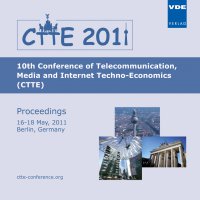Which could be the role of Hybrid Fibre Coax in Next Generation Access Networks?
Konferenz: CTTE 2011 - 10th Conference of Conference of Telecommunication, Media and Internet Techno-Economics
16.05.2011 - 18.05.2011 in Berlin, Germany
Tagungsband: CTTE 2011
Seiten: 12Sprache: EnglischTyp: PDF
Persönliche VDE-Mitglieder erhalten auf diesen Artikel 10% Rabatt
Autoren:
Martín, Angel; Coomonte, Rafael; Feijóo, Claudio (Research Centre for Smart Buildings and Energy Efficiency (CeDInt), Technical University of Madrid (UPM), Pozuelo de Alarcón, Madrid, Spain)
Inhalt:
Next generation access networks (NGAN) will support a renewed communication structure where opportunities lie in the provision of ubiquitous broadband connectivity, a wide variety of new applications, appealing contents and a general support to the sustainable growth of diverse sectors. From their deployment it is expected a wealth of innovations, jobs creation and a new wave of economic growth. In this paper we discuss which could be the role of Hybrid Fibre Coax (HFC) in the Next Generation Access Network (NGAN) roadmap. Thus, we propose a simplified model for making approximate cost calculations for HFC deployment based on the geographic and sociodemographic characteristics of Spain. Considering the latest evolution of HFC based on DOCSIS 3.0 from integrated (I-CMTS) towards modular (M-CMTS), the results from the model are compared with the most competitive NGAN for ultrabroadband speeds: Fibre to the Home (FTTH) based on Gigabitcapable Passive Optical Networks (GPON).


